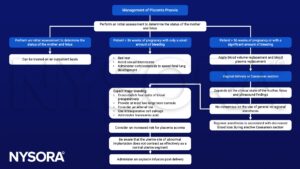Learning objectives
- Description of placenta praevia
- Management of placenta praevia
Definition and mechanisms
- When the placenta attaches inside the uterus near or over the cervical opening
- Classified as a complication of pregnancy
- Commonly occurs around 32 weeks of gestation, however, placenta praevia should be suspected if there is bleeding after 24 weeks of gestation
- Affects approximately 0.5% of pregnancies
- A caesarean section is often required because of the high bleeding risk
- The cause is unknown, however, is thought to be related to abnormal vascularisation of the endometrium caused by scarring or atrophy from previous trauma, surgery, or infection
Classification
- Minor
- Placenta is in the lower uterine segment, but the lower edge does not cover the internal os
- Major
- Placenta is in the lower uterine segment, and the lower edge covers the internal os
- Other than that placenta previa can also be classified as:
- Complete:
- The placenta completely covers the cervix, blocking the vagina
- Partial:
- The placenta partially covers the cervix
- Marginal:
- Placenta is positioned at the edge of the cervix
- Touching but not covering the cervix
- More likely to resolve on its own
- Complete:
Complications
| Maternal | Fetal |
|---|---|
| Placenta accreta Hypotension Antepartum bleeding Placental abruption Postpartum hemorrhage Abnormal placentation | Intrauterine growth restriction Hypoxia Premature infant Low birth weight |
Risk factors
- Previous placenta previa, caesarean delivery, myomectomy, or endometrium damage caused by dilation and curettage
- Younger than 20 or older than 35
- Multiparity
- Smoking or cocaine use during pregnancy
- Pregnant with twins, triplets, or more
- Previous surgery on the uterus
- History of uterine fibroids
Diagnosis
- Ultrasound
Management

Suggested reading
- Pollard BJ, Kitchen, G. Handbook of Clinical Anaesthesia. Fourth Edition. CRC Press. 2018. 978-1-4987-6289-2.
- Plaat F, shonfeldd A. 2015. Major obstetric hemorrhage. BJA education. 15;4:190-193.
- Walfish, M., Neuman, A., Wlody, D., 2009. Maternal haemorrhage. British Journal of Anaesthesia 103, i47–i56.
We would love to hear from you. If you should detect any errors, email us customerservice@nysora.com







